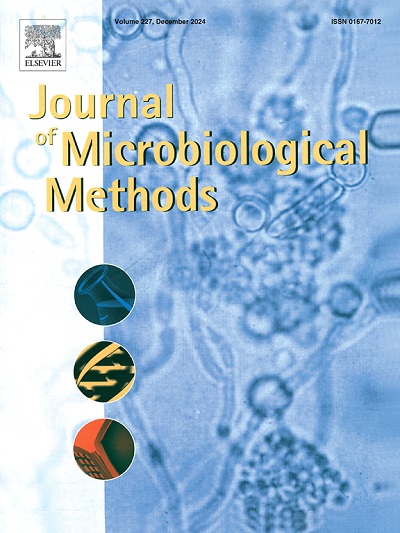用于阴道微生物群研究的乳酸杆菌的定量。
IF 1.9
4区 生物学
Q4 BIOCHEMICAL RESEARCH METHODS
引用次数: 0
摘要
阴道最佳菌群以乳酸菌为主,尤其是马铃薯乳杆菌或干酪乳杆菌。乳酸杆菌产生的乳酸能抑制其他细菌的生长。细菌性阴道病(BV)的特点是阴道乳酸杆菌的耗竭,目前选择的抗生素治疗往往失败,迫切需要新的替代品,包括益生菌或益生元。检测治疗细菌性细菌病的新成分通常采用乳酸杆菌的体外定量。因此,本研究旨在比较crispatus和L. gasseri的定量方法。型菌株分别在酵母膏/蛋白胨/色氨酸/吐温80/葡萄糖(LAPTg)和纽约市ⅲ(NYCIII)肉汤培养基及其限糖制剂(LAPTgr, NYCIIIgr)中培养。通过测量540 nm光密度(OD540)和0 h、8 h、12 h和24 h的平板计数(PC) (CFU/mL)来评估细菌的生长情况。所有时间点的细菌生长测量值进行方差分析,显著性水平为5 %。在LAPTg中观察到较高的OD540读数(p本文章由计算机程序翻译,如有差异,请以英文原文为准。

Quantification of Lactobacillus spp. of interest for the study of the vaginal microbiota
The optimal vaginal microbiota is dominated by Lactobacillus spp., particularly Lactobacillus crispatus or Lactobacillus gasseri. Lactic acid production by Lactobacillus inhibits the growth of other bacterial species. Bacterial vaginosis (BV) is characterized by depletion of vaginal Lactobacillus and treatment with current choice antibiotics often fails urging novel alternatives including probiotics or prebiotics. Testing new components for BV treatment often utilize in vitro quantification of Lactobacillus. Thus, this study aimed to compare methods for L. crispatus and L. gasseri quantification. Type strains were cultured in Yeast extract/peptone/tryptone/Tween 80/glucose (LAPTg) and New York City III (NYCIII) broth media, and their glucose-restricted preparations (LAPTgr, NYCIIIgr). Bacterial growth was assessed by measurements of optical density at 540 nm (OD540) and plate counting (PC) (CFU/mL) at 0 h, 8 h, 12 h, and 24 h. Measurements of bacterial growth at all timepoints were compared with ANOVA at 5 % significance level. Higher OD540 reads were observed in LAPTg (p < 0.05) and NYCIII (p < 0.05) with L. crispatus and L. gasseri when compared to LAPTgr and NYCIIIgr, respectively. However, PC did not differ between LAPTg and LAPTgr (p = 0.628 for L. crispatus; p = 0.161 for L. gasseri). In NYCIII, only L. crispatus exhibited higher PC in NYCIII when compared to NYCIIIgr (p = 0.016). These findings suggest that PC does not reflect Lactobacillus spp. counts under the tested conditions. Future studies exploring BV treatments should combine OD measurements with methods for Lactobacillus quantification other than PC, e. g. molecular methods.
求助全文
通过发布文献求助,成功后即可免费获取论文全文。
去求助
来源期刊

Journal of microbiological methods
生物-生化研究方法
CiteScore
4.30
自引率
4.50%
发文量
151
审稿时长
29 days
期刊介绍:
The Journal of Microbiological Methods publishes scholarly and original articles, notes and review articles. These articles must include novel and/or state-of-the-art methods, or significant improvements to existing methods. Novel and innovative applications of current methods that are validated and useful will also be published. JMM strives for scholarship, innovation and excellence. This demands scientific rigour, the best available methods and technologies, correctly replicated experiments/tests, the inclusion of proper controls, calibrations, and the correct statistical analysis. The presentation of the data must support the interpretation of the method/approach.
All aspects of microbiology are covered, except virology. These include agricultural microbiology, applied and environmental microbiology, bioassays, bioinformatics, biotechnology, biochemical microbiology, clinical microbiology, diagnostics, food monitoring and quality control microbiology, microbial genetics and genomics, geomicrobiology, microbiome methods regardless of habitat, high through-put sequencing methods and analysis, microbial pathogenesis and host responses, metabolomics, metagenomics, metaproteomics, microbial ecology and diversity, microbial physiology, microbial ultra-structure, microscopic and imaging methods, molecular microbiology, mycology, novel mathematical microbiology and modelling, parasitology, plant-microbe interactions, protein markers/profiles, proteomics, pyrosequencing, public health microbiology, radioisotopes applied to microbiology, robotics applied to microbiological methods,rumen microbiology, microbiological methods for space missions and extreme environments, sampling methods and samplers, soil and sediment microbiology, transcriptomics, veterinary microbiology, sero-diagnostics and typing/identification.
 求助内容:
求助内容: 应助结果提醒方式:
应助结果提醒方式:


